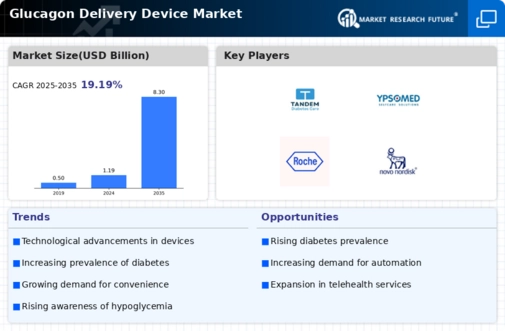Technological Innovations
Technological advancements play a crucial role in shaping the Glucagon Delivery Device Market. Innovations such as automated delivery systems, smartphone integration, and user-friendly interfaces are enhancing the functionality and appeal of glucagon delivery devices. For instance, devices that allow for real-time monitoring and remote access to data are becoming increasingly popular. The market is projected to grow significantly, with estimates suggesting a compound annual growth rate of over 10% in the coming years. These innovations not only improve patient outcomes but also increase adherence to treatment protocols, thereby driving demand for advanced glucagon delivery solutions.
Rising Incidence of Diabetes
The increasing prevalence of diabetes worldwide is a primary driver for the Glucagon Delivery Device Market. As per recent statistics, the number of individuals diagnosed with diabetes has surged, with projections indicating that by 2030, approximately 643 million people will be affected. This alarming trend necessitates effective management solutions, including glucagon delivery devices, to address hypoglycemic episodes. The demand for these devices is likely to rise as healthcare providers and patients seek reliable methods to manage diabetes effectively. Furthermore, the growing awareness of diabetes management options among patients is expected to contribute to the expansion of the market, as individuals become more proactive in their health management strategies.
Shift Towards Home Healthcare
The shift towards home healthcare solutions is transforming the Glucagon Delivery Device Market. With an increasing number of patients managing chronic conditions at home, the demand for user-friendly and effective glucagon delivery devices is on the rise. This trend is supported by data indicating that home healthcare is projected to grow at a compound annual growth rate of approximately 8% over the next five years. Patients prefer devices that are easy to use and can be integrated into their daily routines. Consequently, manufacturers are focusing on developing devices that cater to this need, thereby expanding their market reach and enhancing patient satisfaction.
Regulatory Support and Approvals
Regulatory support and streamlined approval processes are significant factors influencing the Glucagon Delivery Device Market. Recent initiatives by regulatory bodies to expedite the approval of innovative medical devices have created a favorable environment for manufacturers. This support not only encourages the development of new glucagon delivery devices but also enhances market entry for existing products. The approval of devices that meet stringent safety and efficacy standards is likely to boost consumer confidence and increase adoption rates. As a result, the market is expected to witness a surge in new product launches, further driving growth.
Increased Awareness and Education
The growing awareness and education surrounding diabetes management are pivotal in propelling the Glucagon Delivery Device Market. Healthcare campaigns and educational programs aimed at both patients and healthcare professionals are fostering a better understanding of the importance of glucagon in managing hypoglycemia. As patients become more informed about their treatment options, the likelihood of adopting glucagon delivery devices increases. This trend is supported by data indicating that well-informed patients are more likely to adhere to prescribed therapies, which in turn drives market growth. The emphasis on education is expected to continue influencing the market positively.


















Leave a Comment